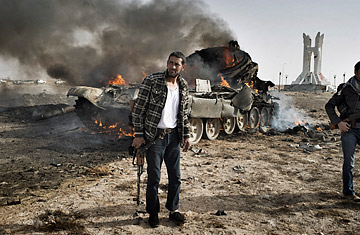
Libyan rebels surround a destroyed Gaddafi tank near Ajdabiyah on March 26, 2011.
The smell of decaying bodies hangs over the rows of loosely packed sand as the caretaker moves through the cemetery on Ajdabiyah's southern edge. Embarak Hamid has buried 81 people in recent days. A group of volunteers from the town, working quickly beneath the searing sunlight, have already cleared a new row. They say they will likely fill it with dozens more bodies by nightfall, as they search the corners of a city laid waste in some places by a government bombardment that lasted 11 days straight.
In little more than 24 hours, the line of Libyan rebel control has lurched forward yet again, sweeping more than 100 miles (160 km) to the west, through the towns of Ajdabiyah, Brega and Ras Lanuf, and along a coastal road of mostly desert sand dunes in between. For 11 days, the pro-rebel town of Ajdabiyah had been under siege, cut off from water and electricity, and subject to seemingly random shelling by the forces of Colonel Muammar Gaddafi. But on Saturday, after a night of allied air strikes, rebel fighters poured into the city and pushed on to the towns further west; they paraded — as they have before — through a morbid playground of war-ravaged streets and shredded tanks. Meanwhile, men who had stayed behind to fight in Ajdabiyah said their families could now return from the outlying villages to which they had fled. Those pushing forward promised again to reach Gaddafi's stronghold of Sert in a matter of days.
But the Libyan civilians populating the front line, as it shifts from Benghazi to Ajdabiyah, Brega and Ras Lanuf, have little doubt that rebel advancement — and safety from government shelling and siege — is heavily, if not entirely, dependent on allied air strikes. It's a fact that is troubling to both the rebel fighters and the Western governments seeking to extricate themselves from an increasingly complicated civil war. But without their assistance, the residents say, their towns would have been totally devastated and both rebels and rebel sympathizers hunted down, kidnapped or killed.
For a number of people, the missiles that freed Ajdabiyah after a week of stalemate came far too late. Much of the town is now silent and abandoned; the bullet holes and collapsed walls of apartment blocks and storefronts bear witness to the city's scourging by Gaddafi. Charred, shattered dishes, pots and pans, and the heavy metal shards of armaments, lie in the blackened rubble of one anonymous family's kitchen in a first-floor apartment in the 7th of October neighborhood. A crushed baby carriage and television set lie in the ruin of another room, and the charred refrigerator door hangs open to a swarm of flies, allowing someone's asthma medication to incubate on a rack beside the remains of rotting food.
As Ajdabiyah's residents and visitors from the east flood back into this newly liberated ghost town, other frightening questions remain unanswered. In the cemetery, some of the graves carry the handwritten names — and little else — of the people who were killed, scratched into small slabs of wet concrete. But 15 of the mounds are marked only by numbers — corresponding to images on a wall in the hospital's lobby, the gruesome, still unidentified pictures of the dead that overwhelmed morgue workers during the siege. Thirty-eight others are buried without any marker whatsoever. And still others are gone without a trace. Peter Bouckaert of Human Rights Watch says that a couple of international aid organizations including the International Committee of the Red Cross and the Red Crescent have compiled a list of some 175 missing persons from Benghazi alone. The other towns, now quickly being liberated, will have to be tallied as well.
In the lobby of Ajdabiyah's hospital, fear furrows the brows of a small crowd of people who have arrived to search for loved ones. Nasser Ahmed al-Hawari is still looking for his brother and neighbor who vanished from the front line nearly three weeks ago; he has already scoured the hospitals and morgues of Benghazi. Awad Khashkash traveled from Darnah to look for a 20-year-old neighbor, missing for a week. And a lone woman in a headscarf and long black coat moves from group to group, searching for her 22-year-old son, Seraj Abdel Hani, who vanished just the day before. "He was with a group yesterday in the battle in Ajdabiyah," she says. "The group he was with said he was hit around 1 p.m." But none of the pictures on the wall are of her son.
